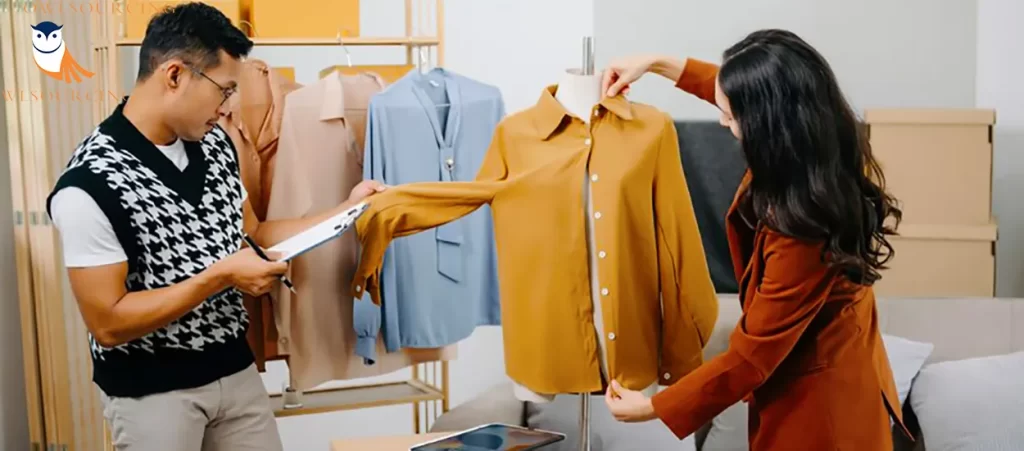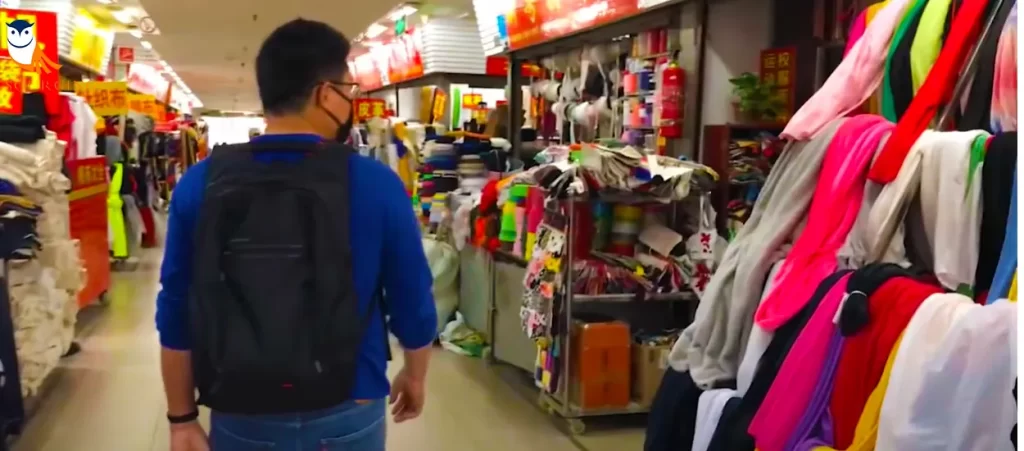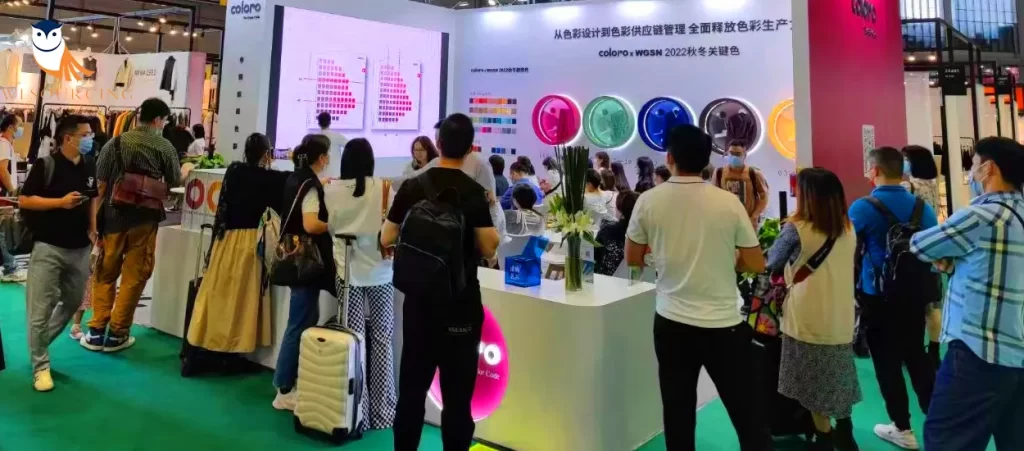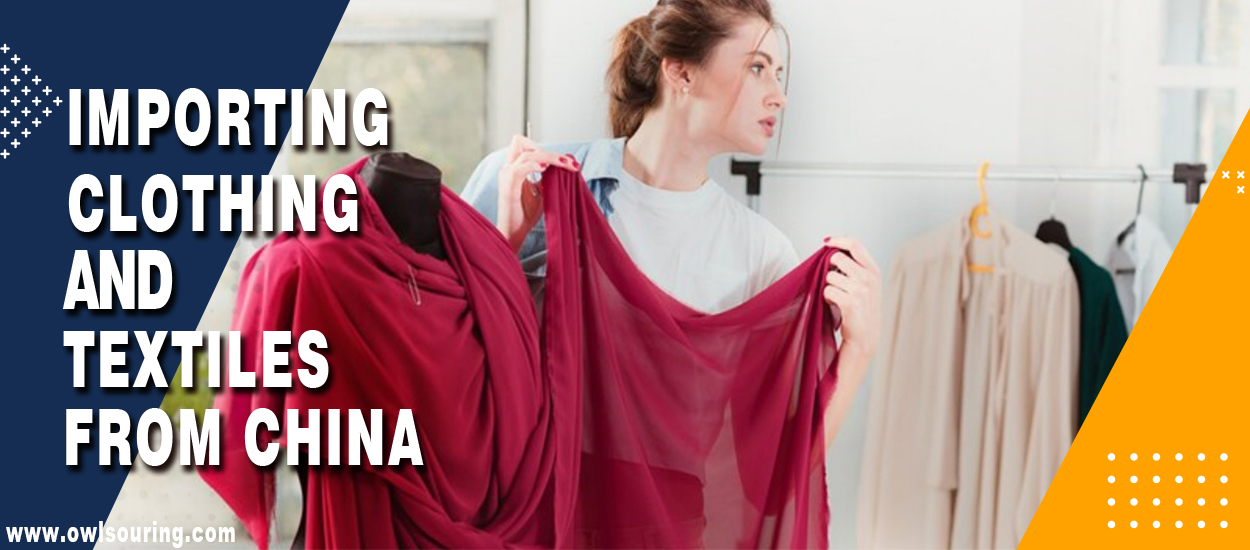There are three steps for you to open up your knowledge on how to import cloth from China: The basic of understanding the production district system, the ability to distinguish the characteristics of the products, and the ability to identify how to handle your supplier.
On the other hand, it is a market that has immense potential to expand. However, navigating the market might be challenging.
There is much to note, from the sourcing process to shipping. However, once you find the rhythm, it is easy. In this extensive guide, we cover all you need to know. Continue reading to learn the steps to take and stand out.
Why Import Clothing and Fabrics from China?

Many first-time importers have asked me this question. It is a pretty good question. I mean, there are several clothing markets, including local ones. So, why import from China?
First, the country has one of the fastest-growing fabric and clothing industries. It keeps taking longer strides and beating expectations.
The Chinese clothing manufacturers produced more than 3.23 billion meters of clothing fabric – in April 2022. The country has a 31.6% share of the global market.
Here are five solid reasons why China is an excellent choice:
- Competitive Prices: China is well-known for its low manufacturing and labour costs. Since the country’s low capital, it can afford to lower its prices. It is different from countries that have higher manufacturing and labour costs.
- Quality Products: China has many talented craftsmen. It is also technologically advanced, which has led to more quality products. China also blends traditional and modern styles, giving products a timeless design.
- Wide Range of Products: Fabric and clothing are among the most diverse markets. Several clothing materials can be used to make countless types of products. You are open to various options when you visit a Chinese fabric market.
The products are from knitting and sewing machines. They include sweaters, skirts, dresses, and several types of underwear. All these fabrics, from linen to cotton, are available. Plus, they come in different forms. You would find tablecloths and even knitted outfits.
What Are the Main Clothing and Textile Markets in China?

China has an extensive chain of markets. There are tons of options for selling different products. About 44 thousand companies deal in textiles and apparel in China. These many companies mean you can expect various options.
When I was visiting different places in China a while back, I couldn’t fathom how many different clothing items were on sale.
The media doesn’t do justice to it. The markets were packed with clothes and fabrics. There was a modern style I was used to staying in the US.
Then, there were other unique styles imbued with Chinese culture. It will be close to impossible to mention all the different companies. You will find these companies in Jiangsu, Fujian, Guangdong, and other neighbouring regions.
Some notable places include:
| Market Name | Location | Notable Features | Key Products |
| Keqiao Fabric Wholesale Market | Shaoxing, Zhejiang | Largest fabric wholesale market in China. An extensive variety of textiles, both traditional and modern. | Fabrics, textiles, and apparel materials |
| Shanghai Fabric Market | Shanghai | Known for high-quality fabrics and a vast range of textile products. | Fabrics, accessories, and garments |
| Guangzhou Zhongda Fabric Market | Guangzhou, Guangdong | Largest fabric market in southern China.
One of China’s most important textile and clothing trade centres. |
Fabrics, clothing, and home textiles |
| Jinyi Light Textile City | Zhengzhou, Henan | Major textile wholesale centre in central China. Known for offering both high-end and budget-friendly fabrics. | Fabrics, light textiles, and apparel |
| Sijiqing Clothing Wholesale Market | Hangzhou, Zhejiang | Famous for clothing, but also has a wide range of fabric vendors.
One of the largest clothing and fabric markets in China. |
Fabrics, garments, and accessories |
| Shengze Fabric Market | Suzhou, Jiangsu | Known as the “Silk Capital of China,” this market specialises in silk fabrics and various textile options. | Silk, synthetic fabrics, and textiles |
Key Strategies for Successful Clothing Sourcing in China
This table shows a clear pathway to successful apparel sourcing: manufacturing specialisation, verification of the credentials of suppliers, and identification of traders provide the trifecta to find reliable partners.
Are Chinese Textiles and Clothing of Good Quality?
Like most markets, the quality of Chinese garments is on a spectrum. Contrary to popular belief, Chinese products are not of low quality.
Instead, their quality ranges from poor to excellent. There are steps you can take to ensure quality always.
These steps include choosing a trusted platform with a good track record. You can spot these suppliers by reading reviews and opting for factory inspections.
Also, you can request samples when you find a manufacturer that interests you. But how do you get the right supplier? Let’s talk about it.
How to Find Clothing and Fabrics Suppliers From China?
Many of the textile markets are nestled in the country’s eastern side. Aside from these markets, there are also industrial parks.
However, going to these spots can still make it difficult to find the right option. Here is how to find the ideal supplier to meet your business needs.
1) Hire a Third-party Agency to Source Suppliers
If you are new and have a bit of cash to spare, opt for third-party agencies. These agencies can save you time and effort, especially if you are not experienced. They also prevent you from working with an unprofessional supplier.
The Role of a China Sourcing Agent
Owlsourcing’s manager, Andy, offers the following advice:
“As the Owlsourcing service manager, Andy emphasises the significance of quality assurance when sourcing clothes and fabrics from China.
He underscores the importance of due diligence and vetting suppliers to ensure that the products meet international quality standards.
Andy believes that while China offers a vast array of clothing and fabric options, the key lies in establishing strong supplier relationships built on trust, communication, and stringent quality control measures.
By prioritising these factors, businesses can indeed access good-quality clothes and fabrics from China and tap into the country’s manufacturing expertise effectively.”
2) Find the Supplier Via the B2B Marketplace
You can start sourcing for your desired supplier right from home. You can do this with e-commerce stores like Alibaba and Global Sources. These platforms are established B2B stores.
They have many Chinese suppliers and are great for connecting.
Generally, these platforms allow you to contact the suppliers directly. Hence, you can connect and negotiate with the supplier that interests you.
Also, you can read up on their reviews and ask other buyers about their experience. However, knowing that each supplier’s quality might vary is important. Hence, you must still invest in quality control using third-party inspection services.
Here we discussed “12 Sites Like Alibaba for Sourcing” and “Top Chinese Wholesale Websites to Buy from China“. Don’t miss it.
3) Leverage Chinese Exhibition Shows

Many companies invest in hosting several fashion shows and trade fairs in China. These opportunities are perfect to see the product and connect with manufacturers. Here are some of the fashion exhibitions:
- Canton Fair
- China International Fashion Fair
- Yiwu Trade Fair
- East China Import and Export Commodity Fair
And also:
| Trade Show | Location | Schedule | Key Product Categories |
|---|---|---|---|
| Global Sources Fashion Show | Hong Kong | January (Fall/Winter) and July (Spring/Summer) | Bags & Luggage, Fashion Jewellery, Scarves, Gloves, Belts, Footwear, Socks, Children’s Apparel, Fabrics, Sportswear |
| Knitwear, Down Jackets, Swimwear, Beachwear, Sleepwear, and Underwear | |||
| Canton Fair (Phase 3) | Guangzhou, Mainland China | April/May and October/November (Biannual) | Men’s & Women’s Apparel, Children’s Wear, Leather, Fur, Casualwear, Fashion Accessories, Home Textiles |
| Textile Raw Materials, Carpets, Shoes, Stationery, Travel Gear, and Recreational Goods | |||
| Hong Kong Fashion Week | Hong Kong | January (Fall/Winter) and July (Spring/Summer) | Women’s & Men’s Apparel, Baby Wear, Activewear, Swimwear, Eveningwear, Handbags, Shoes, Costume Jewellery |
| Fabrics, Trimmings (Buttons, Labels), and Certification Services |
4) Find Suppliers on LinkedIn
LinkedIn is a well-known social media platform where businesses connect. Although the platform is banned in the country, it is still an avenue to meet suppliers.
You can search for these suppliers. An alternative is joining groups to connect with other buyers and suppliers.
Optimise Your Fashion Imports with Expert Sourcing
Clothing imports from China present immense opportunities for companies that want to expand their operations.
Whether you require fabric sourcing in China, advice on importing clothing from China, or assistance from a trustworthy fabric sourcing agent in China, collaboration with a seasoned partner guarantees a smooth experience.
From clothing sourcing in China to linking companies with cut-and-sew factories in China, we assist companies in navigating supply chains effectively.
If you’re considering importing clothes from China and would like to learn about the price of importing clothes from China or need assistance in importing clothes to the United States, our sourcing solutions can save you time and money.
If you’re looking for China’s organic cotton factories, Chinese quality fabrics, or China’s textile import suppliers, we have tailored solutions for you.
We can make the process of importing your clothes from China easier—contact us now!
Everything You Need to Know About Importing Private-label Clothing From China
Private-label clothing is usually sourced from ODMs or Original Design Manufacturers. These suppliers offer you samples that you can run using your company’s name, but they are not as exhaustive as far as their product portfolio is concerned.
Critical Specifications to Provide:
- Sizes and quantities, Design sketches, Fabrics, types of yarns, and types of colour. These include quality requirements, treatments, and coatings.
- Governance standards (for example, safety control, restrictions on the utilisation of certain substances). State information regarding the kind of washing and treatment that should be given to the item, the origin of the cloth used in the item, and the type of material used.
- Logo files are created to brand specific products for manufacturer specialisation.
Chinese factories are usually divided by the type of product and sector, such as sportswear, fitness, cycling, etc. The supplier must fit your particular needs because they may source their materials from subcontractors, which will affect the quality of the end product.
Ensuring Product Quality: To protect the quality of your clothing, include strict parameters for fabric, such as the colour, type of fabric, sample of the fabric, or request to use organic cotton. This aids in reducing possible variations between the final output.
Tips For Sourcing Clothing and Fabric Manufacturers in China
So, what tips can you take to ensure you source the right manufacturers? Below are the tips that you can take to ensure you get the best experience.
1) Find the Right Suppliers for Your Business Size
There are suppliers for big businesses. Then, those are better suited for smaller businesses because of their MOQ. Choosing the right Chinese suppliers prevents complications associated with order sizes.
While a minimum order quantity from Chinese manufacturers can be understood by buyers from Asia, especially those from other developing countries, Western buyers find it rather odd.
These MOQs can be discussed and changed depending on several circumstances.
Types of Minimum Quantities:
- Per Product: This means that manufacturers have set limits to the number of units that must be manufactured to break an equal number of profits. In most cases, the factory has the discretion to determine this particular aspect.
- Per Size: There is always a business order of units that is commonly recommended when it comes to setting the sizes to produce. Note that these size quantities must be verified before finalising an order value.
- Per Fabric and Colour: High MRO costs are a result of minimum order quantities for each fabric type and colour used in production, since fabrics and materials are purchased from subcontractors. Instead, these subcontractors have their own standards that manufacturers have to adhere to as well.
2) Pick Suppliers with a Formal Manufacturing System
There are several certifications. Suppliers with these certifications are more legitimate and trustworthy. Plus, they often have higher-quality products and more production capabilities.
3) Choose Suppliers That Match Your Speciality
There are tons of suppliers. However, some suppliers specialise in something more than others. For instance, there is a supplier which specialises in linen. Then, some suppliers make underwear and other products.
Match your products with the supplier for the best products.
4) Shipping
Pick a shipping method that aligns with your business needs. Choose air freight if the delivery is urgent and you can spare the cost. However, sea freight is a much more affordable alternative.
There are freight forwarders you can use, too. This option helps you avoid any customs complications you would typically face. Handling customs alone can be stressful.
How You Can Reduce the Risks Associated with Importing from China
Sourcing products is a challenge and often has lots of risks. To ensure a seamless experience, you can learn about these risks and how to handle them. Here are three ways you can guarantee that you have a risk-free experience:
1) Inspect the Goods
Inspecting the goods you hope to receive before they are shipped to you is wise. This practice saves you a lot of money. It reduces the instances of ending up with fake products.
If you can’t be there to inspect the products physically, you can hire a third party. Many organisations do this.
All you need to do is pay a small fee. The third-party quality inspection in China usually ranges from the entire production to the pre-shipment inspection. Note that both options vary in cost.
2) Testing the Products
You can send the products to independent and unbiased testing labs. Here, they will test the clothing or fabric to ensure they are up to par in quality.
The test reveals many aspects of the products. It offers insights into the fabric composition, colour, and other important details. Some of these details can shed light on the quality of the materials.
3) Audits
Audits are crucial to ensure that the company follows best practices. These audits provide the company with the machinery and practices to follow the standard. It also ensures your product line is the best throughout your supplier partnership.
Note: Like any business, imports are risky. However, following these measures lowers the risks. You can also opt to use escrow services. It ensures the supplier is paid after you receive and approve your delivery.
Legal and Regulatory Considerations of Importing Clothes and Fabrics
There are different legal and regulatory considerations when importing fabric and clothes. These considerations ensure that your goods are cleared at customs. I usually discuss a few of these documents.
However, the clothing market is rapidly evolving, and regulations are changing. That said, I recommend you discuss it with an attorney.
This way, you are guaranteed a seamless experience. Also, this tip applies to the regulations regarding intellectual property.
U.S. Clothing Standards and Requirements
You should also consider policies issued by government agencies when planning to ship products to the U.S. market.
You will need to familiarise yourself with some of the regulations provided by such government agencies that have been set.
For example, the Federal Trade Commission (FTC) relates to fibre content disclosure, care labelling, and flammability requirements, among others.
1. FTC and Fibre Content Disclosure:
The Federal Trade Commission (FTC) has stated that the fibre content must be labelled as required under the Textile Fibre Products Identification Act (TFPIA).
Non-functional fibres do not require being declared if their concentrations are below 5% each.
Note: Linings should be labelled separately, and all textiles should go by their chemical names and not their trade names.
2. Care and Labelling Instructions:
Garments should also have modernised care instructions that consider eco-friendly cleaning alternatives.
As an example, labels should indicate machine wash settings through symbols that are consistent with both environmental standards and consumers’ preferences for sustainable care.
More specific care labels may also be required for environmentally friendly fabrics such as organic cotton.
3. Material and Component Labels:
The material and component label need to show what blends of artificial fibres, such as polyester or nylon. Further, the label also needs to include the Global Organic Textile Standard (GOTS) for organic fabrics.
4. Size Standards:
In the U.S., people are generally more likely to use standard-size categories such as XS, S, M, L, XL, etc.
Please pay attention to whether the products you buy clothes in China use these size standards.
5. Flammability Performance:
If the types of clothing you import from China are primarily children’s sleepwear, you also have to comply with the Consumer Product Safety Commission’s (CPSC) flammability standards.
Sleepwear made of designated fabrics like polyester has to be tested for flame resistance. The new updates of CPSC also need further testing of fabrics used in children’s clothing under the age of 9 years for fire safety.
6. Dye and Colour Fastness:
The Consumer Product Safety Improvement Act, CPSIA, also mandates means used in apparel, like dyes, should be proven non–toxic and colourfast.
Some dyes, such as azo dyes that discharge carcinogenic bay chemicals, are banned from being used in specific categories of garments.
Colourfastness to light and washing has to be tested so the colour does not bleed.
7. Wearability and Comfort:
Garment wearability has become a key consumer expectation. This includes ergonomic design, ease of movement, and soft finishes.
Many consumers now prefer clothing made from moisture-wicking or temperature-regulating fabrics, especially in activewear.
8. Country of Origin Labelling:
The country of origin label must be present for all garments sold in the U.S. In some cases, additional details such as the region or specific city where the garment was manufactured can add transparency, especially in regions with high labour standards.
9. Tariffs and Import Taxes:
Tariffs for textile products have fluctuated due to changing trade policies.
As of 2024, U.S. tariffs on Chinese apparel products vary, with specific duties on garments such as socks, gloves, and certain synthetic fabrics.
10. Safety Testing:
The CPSC requires rigorous safety testing for children’s apparel, particularly for items like toys, baby bibs, and sleepwear.
Beyond small parts hazard testing, chemical and lead testing have become more stringent, with some items being tested for choking hazards under ASTM F963-17.
11. Flammability Labels:
Clothing like sleepwear must not only adhere to flammability standards but also feature warning labels when certain fabrics or finishes are used.
For instance, “Warning: Keep Away from Fire” is a typical label used for non-compliant sleepwear items.
Read More:
- How to Import Baby Clothes from China
- How to Source Products From China
- Top Products Imported from China
- Top Chinese Boutique Clothing Wholesalers
- China Factory Distribution in Eastern China
Final Thoughts
Importing clothes and fabric is like importing other devices. You must be cautious and follow all the steps this guide highlights. We have covered how to find a manufacturer in China and mitigate the risks of importation.
Nonetheless, we know this process can be overwhelming for a first-timer. Hence, we recommend you hire a sourcing agent. If you need help on these grounds, you can contact us. We are ready to assist with all the steps of the way.



6 thoughts on “How to Import Clothes and Textiles from China for Your Brand”
Is it necessary to apply for a quota from the Chinese government when exporting fabric, including materials like cotton, from China?
Thank you for your comment! Generally, you do not need to apply for a quota from the Chinese government when exporting fabric, including cotton, from China. However, it’s essential to comply with export regulations and documentation requirements. For specific cases or further details, feel free to contact us anytime. We’re here to help!
Hello,
I found your article on importing clothing and textiles from China incredibly informative. I’m currently in the process of expanding my business and am interested in sourcing unique fabrics. Could you provide recommendations for reputable suppliers who specialize in custom textile designs? I have specific patterns and material requirements in mind and would appreciate any insights you can share. Also, considering my location in Australia, I’m keen to know about their shipping capabilities to ensure a smooth import process.
Thank you for your expertise!
Hi shun,
I’m glad you found the article helpful! For sourcing custom textile designs from China, I recommend exploring specialized suppliers on platforms like Alibaba, Global Sources, or through the China Textile City market. Look for suppliers that offer customization services and have positive feedback. Ensure they have experience shipping to Australia, possibly by verifying their logistics partnerships or checking if they use major shipping services like DHL or FedEx. It’s also important to confirm their adherence to quality standards relevant to your needs.
Good luck with your business expansion!
Fantastic read on importing textiles from China! Being in the fashion industry, the emphasis on staying trendy resonated with me. Can you be deeper into the latest textile trends or any emerging materials worth exploring? Excited to learn more!
Hi Grace. Thank you for your enthusiasm! I’m delighted you found the article insightful.
As for diving deeper into textile trends, exploring eco-friendly materials like recycled polyester and Tencel has gained popularity. Also, innovative textiles that incorporate technology for durability and sustainability are trending.
I’d recommend keeping an eye on global fashion shows and industry reports for the latest updates. Excited to provide more insights as you explore these new trends!